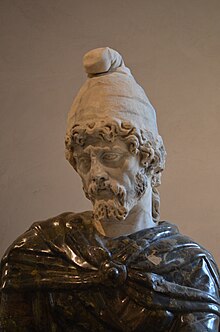
The Phrygian cap (/ˈfrɪdʒ(iː)ən/ FRIJ-(ee)-ən), also known as Thracian cap[1][2][3] and liberty cap, is a soft conical cap with the apex bent over, associated in antiquity with several peoples in Eastern Europe, Anatolia and Asia. The Phrygian cap was worn by Thracians, Dacians, Persians, Medes, Scythians, Trojans, Amazons and Phrygians after whom it's named.[4] The oldest known depiction of the Phrygian cap is from Persepolis in Iran.
Although Phrygian caps did not originally function as liberty caps, they came to signify freedom and the pursuit of liberty first in the American Revolution and then in the French Revolution,[5] particularly as a symbol of Jacobinism (in which context it has been also called a Jacobin cap). The original cap of liberty was the Roman pileus, the felt cap of emancipated slaves of ancient Rome, which was an attribute of Libertas, the Roman goddess of liberty. In the 16th century, the Roman iconography of liberty was revived in emblem books and numismatic handbooks where the figure of Libertas is usually depicted with a pileus.[6] The most extensive use of headgear as a symbol of freedom in the first two centuries after the revival of the Roman iconography was made in the Netherlands, where the cap of liberty was adopted in the form of a contemporary hat.[7] In the 18th century, the traditional liberty cap was widely used in English prints, and from 1789 also in French prints; by the early 1790s, it was regularly used in the Phrygian form.
It is used in the coat of arms of certain republics or of republican state institutions in the place where otherwise a crown would be used (in the heraldry of monarchies). It thus came to be identified as a symbol of republican government. A number of national personifications, in particular France's Marianne, are commonly depicted wearing the Phrygian cap. Scientists pointed to the cultural and historical relationship of the Phrygian cap with the kurkhars—the national female headdress of the Ingush people.[8] The protagonists of the Belgian comic series The Smurfs wear white phrygian caps.
- ^ Tsiafaki, Despoina. "Ancient Thrace and the Thracians through Athenian eyes." Thracia 21 (2016): 261-282.
- ^ Herodotus, 6.45 and 7.73, "Thus fared the fleet; and meanwhile Mardonios and the land-army while encamping in Macedonia were attacked in the night by the Brygian Thracians, and many of them were slain by the Brygians and Mardonios himself was wounded."; "Now the Phrygians, as the Macedonians say, used to be called Brigians during the time that they were natives of Europe and dwelt with the Macedonians; but after they had changed into Asia, with their country they changed also their name and were called Phrygians. The Armenians were armed just like the Phrygians, being settlers from the Phrygians."
- ^ Strabo, 7.3.2, "Now the Greeks used to suppose that the Getae were Thracians; and the Getae lived on either side the Ister, as did also the Mysi, these also being Thracians and identical with the people who are now called Moesi; from these Mysi sprang also the Mysi who now live between the Lydians and the Phrygians and Trojans. And the Phrygians themselves are Brigians, a Thracian tribe, as are also the Mygdonians, the Bebricians, the Medobithynians, the Bithynians, and the Thynians, and, I think, also the Mariandynians. These peoples, to be sure, have all utterly quitted Europe, but the Mysi have remained there. And Poseidonius seems to me to be correct in his conjecture that Homer designates the Mysi in Europe (I mean those in Thrace) when he says, "But back he turned his shining eyes, and looked far away towards the land of the horse-tending Thracians, and of the Mysi, hand-to‑hand fighters" for surely, if one should take Homer to mean the Mysi in Asia, the statement would not hang together."
- ^ "Phrygian cap | Definition, History, & Facts". Encyclopedia Britannica. Retrieved 11 November 2020.
- ^ Richard Wrigley, "Transformations of a revolutionary emblem: The Liberty Cap in the French Revolution, French History 11(2) 1997, p. 132.
- ^ Carol Louise Janson, "The Birth of Dutch Liberty. Origins of the Pictorial Imagery", Diss. phil. University of Minnesota 1982 (microfilm), p. 35.
- ^ ibd. p. 98.
- ^ Semyonov 1959.